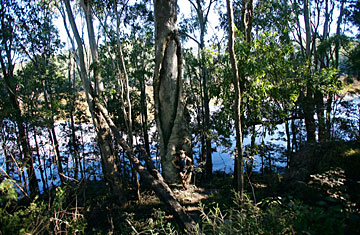
The bark cut from this tree was probably used to make a canoe, says local historian Matthew
(2 of 2)
The sun is shining on a clear day, the water dances with light and the occasional leisure boat glides past, but Grenville sees the river differently from most people. "I find the whole valley has a rather dark mood," she says.
Seven years ago she came to Wiseman's Ferry to flesh out her planned memoir, armed with not much more than a ghost story. Family legend had it that her great-great-great grandmother Jane had been thrown to her death down the stairs of Cobham Hall, and that her spirit still haunted a former bedroom of the inn. But staying overnight in Room 9, Grenville did not so much come face to face with Jane Wiseman's ghost as with the ghost of an idea for a novel. At breakfast the following morning, she noticed how the rear of the inn, which faces a hill, was windowless, with a small, squat door cut through meter-thick stone, "and suddenly I realized that you could see this whole house as a fortress," Grenville says. She recalled seeing a 19th century watercolor of Wiseman's villa, ringed by a high stone wall, "and at that point I decided that actually something had happened — that is, a novelist working on the slenderest of evidence and extrapolating ... That's where I left Solomon Wiseman behind."
Also at the pub, Grenville met the bearded, barefoot botanist, an unofficial guide to the area's Aboriginal archaeological sites. Luckily for Grenville, Patrick Matthew warmed to her spirit of inquiry — "I happen to be a fairly literary person," he says — and over time, he began sharing the forest's hidden history with the novelist. "There are carvings on flat rocks right up on the ridge tops there," he says, pointing up from the ferry station, "paintings on the walls of caves, and axe-grinding grooves, artifacts. One finds the occasional axe or spearhead or something like that." Around the same time, Grenville had begun reading old Sydney Gazette accounts of skirmishes between settlers and Darug Aborigines in the years leading up to Wiseman's arrival on the Hawkesbury in 1817. Only the year before, Governor Lachlan Macquarie had issued an order allowing settlers, besieged by crop burnings and spearings, to shoot Aborigines on sight. While she could find nothing about Wiseman's own dealings with the Darug, the reports got Grenville thinking. Following her field trips to Aboriginal sites with Matthew, "I knew what to do now," she writes in Searching for the Secret River, "which was, in a manner of speaking, to do nothing."
Or, rather, to let her imagination go to work. As well as the Sydney Gazette reports of "outrages and depredations," Grenville had read up on the Myall Creek massacre of 28 Aborigines by stockmen near Inverell, northern N.S.W., in 1838, the year of Wiseman's death. In her mind's eye, the events merged. These are the secrets slowly revealed in Grenville's novel, as William Thornhill and family face the threat of escalating violence on their bend of the river, leaving in its wake "a great shocked silence hanging over everything."
The poetic persuasiveness of Grenville's writing, her story's gritty verisimilitude, and her transpositions of real people and events have made some historians uncomfortable. But she wasn't trying to write history, she says: "It is just a powerful possibility. This is not something I'm saying happened to Solomon Wiseman. It might have, it might not have. I don't know."
History is, of course, about knowable facts. But while Darug specialist Jim Kohen, an associate professor at Sydney's Macquarie University, doubts that a massacre on the scale of Myall Creek happened on the Hawkesbury, his research is sobering. Kohen estimates that up to 200 Aborigines were killed in armed conflict along the river between 1794 and 1800, compared to 26 European settlers. "You also need to remember that at least 50% of the population died of smallpox before Europeans ever reached the Wiseman's Ferry area," Kohen says.
These days, descendants of the Darug and neighboring Darkinjung tribes still speak of a massacre that they believe took place in the Forgotten Valley of nearby St. Albans. Patrick Matthew, for one, has no doubts. "I have spoken to one or two people up at St. Albans, real oldies, who showed me the site of the last Aboriginal deaths at what they call the common up there," he says. "So it's quite definite that there were problems and difficulties."
While historians still grapple with the Hawkesbury's contested past, through her fiction, Grenville has found a kind of peace. "Whether or not my ancestors specifically shot any Aborigines doesn't really matter," she says. Solomon Wiseman "was part of a movement that displaced and dispossessed the Aboriginal people. So what I feel is nothing as simple as guilt, but it's certainly a desire to at the least acknowledge that that's what happened, and to regret it."
In this way, her recreated river realm, with its yam daisies restored, stands as a powerful microcosm. "It was the story of settlement in miniature," Grenville writes in Searching. And a river runs through it.